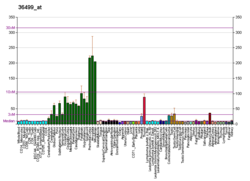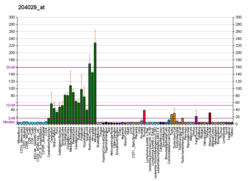| CELSR2 |
|---|
|
| Identifiers |
|---|
| Aliases | CELSR2, CDHF10, EGFL2, Flamingo1, MEGF3, ADGRC2, cadherin EGF LAG seven-pass G-type receptor 2 |
|---|
| External IDs | OMIM: 604265; MGI: 1858235; HomoloGene: 1078; GeneCards: CELSR2; OMA:CELSR2 - orthologs |
|---|
| Gene location (Human) |
|---|
 | | Chr. | Chromosome 1 (human)[1] |
|---|
| | Band | 1p13.3 | Start | 109,249,539 bp[1] |
|---|
| End | 109,275,751 bp[1] |
|---|
|
| Gene location (Mouse) |
|---|
 | | Chr. | Chromosome 3 (mouse)[2] |
|---|
| | Band | 3 F3|3 47.02 cM | Start | 108,298,167 bp[2] |
|---|
| End | 108,323,383 bp[2] |
|---|
|
| RNA expression pattern |
|---|
| Bgee | | Human | Mouse (ortholog) |
|---|
| Top expressed in | - ganglionic eminence
- prefrontal cortex
- hippocampus proper
- postcentral gyrus
- Brodmann area 9
- superior frontal gyrus
- entorhinal cortex
- Region I of hippocampus proper
- right uterine tube
- skin of abdomen
|
| | Top expressed in | - superior surface of tongue
- gallbladder
- lip
- subiculum
- superior frontal gyrus
- visual cortex
- motor neuron
- ascending aorta
- extensor digitorum longus muscle
- supraoptic nucleus
|
| | More reference expression data |
|
|---|
| BioGPS | 
 | | More reference expression data |
|
|---|
|
| Gene ontology |
|---|
| Molecular function | - G protein-coupled receptor activity
- signal transducer activity
- calcium ion binding
- transmembrane signaling receptor activity
| | Cellular component | - integral component of membrane
- plasma membrane
- membrane
- cytoplasm
| | Biological process | - homophilic cell adhesion via plasma membrane adhesion molecules
- regulation of transcription, DNA-templated
- cell surface receptor signaling pathway
- multicellular organism development
- regulation of cell-cell adhesion
- Wnt signaling pathway, planar cell polarity pathway
- G protein-coupled receptor signaling pathway
- signal transduction
- neural plate anterior/posterior regionalization
- Wnt signaling pathway
- cell adhesion
- dendrite morphogenesis
- cell-cell adhesion
| | Sources:Amigo / QuickGO |
|
| Orthologs |
|---|
| Species | Human | Mouse |
|---|
| Entrez | | |
|---|
| Ensembl | | |
|---|
| UniProt | | |
|---|
| RefSeq (mRNA) | | |
|---|
| RefSeq (protein) | | |
|---|
| Location (UCSC) | Chr 1: 109.25 – 109.28 Mb | Chr 3: 108.3 – 108.32 Mb |
|---|
| PubMed search | [3] | [4] |
|---|
|
| Wikidata |
| View/Edit Human | View/Edit Mouse |
|




















